Bad good machine
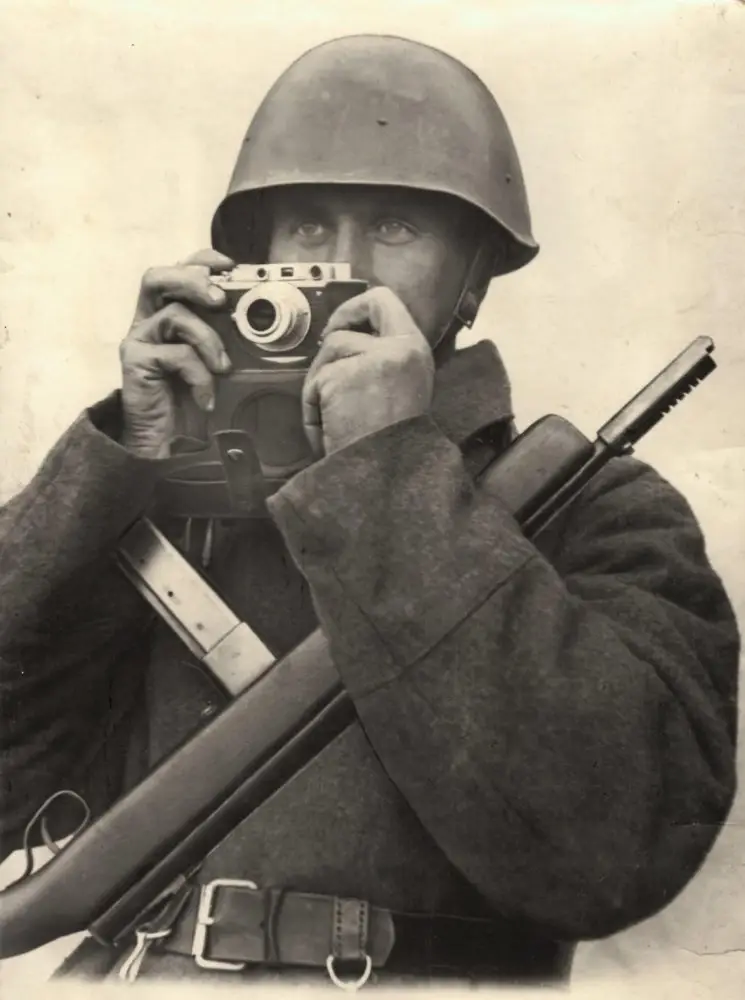
A Red Army soldier with a “Raising M50” submachine gun.
Eugene Reising was an amateur marksman and a talented weapons engineer. He sincerely believed that the creations of gunsmiths should first of all satisfy the needs of the end consumer, that is, a shooter or a soldier in the field. Reising himself was a big fan of shooting competitions, and he had the opportunity to work with the legendary John Moses Browning. He took part in fine-tuning the Browning design, which later became the legendary 1911 pistol produced by Colt.
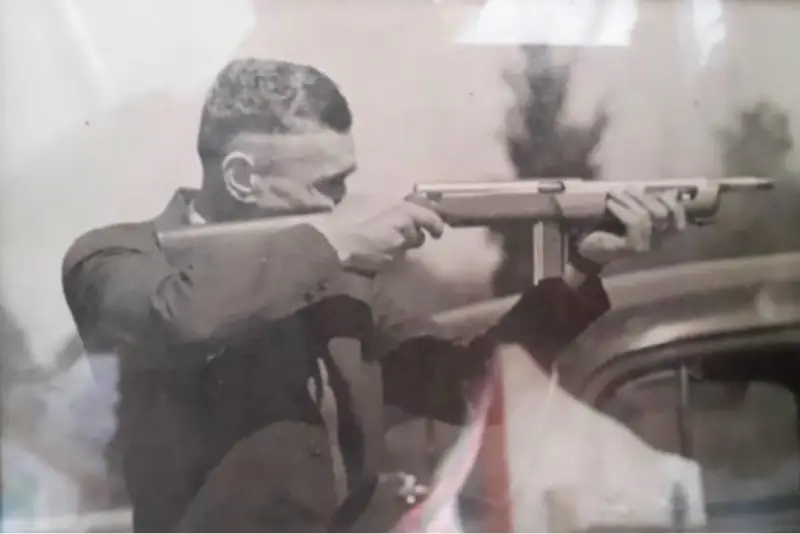
Eugene Reising with a prototype of his weapons, 1939. It is clearly visible that the cocking handle is located in a niche in the forend, but has not yet been moved down.
Reising developed several small-caliber pistols, and in 1938 he decided to take on the most promising weapon, in his opinion, a submachine gun. Before everyone’s eyes were the events of the civil war in Spain, where these weapons were more than actively used, and many guessed that the fire of a global conflagration was actually starting to flare up.
Two years later, the gunsmith presented his creation. Reising did not have his own production facilities or a manufacturer behind it, and he offered his submachine gun to various manufacturers. As a result, the company managed to interest the Harrington and Richardson Arms Company (H&R) in Worcester, Massachusetts, where production was launched in March 1941. According to the contract, the inventor himself was entitled to a commission of $2 for each sample sold.
The production of the Model 50, a full-size submachine gun, began, and a month later the Model 55 with a folding wire stock, as well as a shorter one due to the absence of a compensator muzzle brake. A self-loading carbine was also produced under the index 60. All weapons were produced in .45 ACP caliber.
It is clear that at first the main consumers were supposed to be various law enforcement agencies. While General Thompson’s creation reigned supreme on this market, and its cost scared off many, so Reising created a model that was more than competitive on the market.
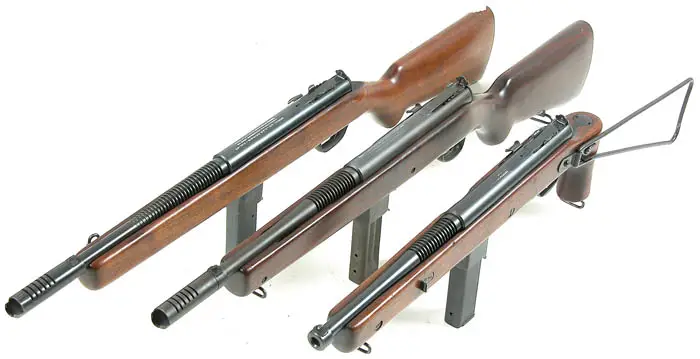
But it was clear that we had to offer our weapons to the military. There will be prospects and volumes, especially since the war was already going on in Europe, the Japanese had been at war with the Chinese for several years, many in the United States understood that sooner or later one of these conflicts would affect them too.
And the first approach to the projectile took place in November 1941. Tests conducted by the US Army took place at Fort Benning, Georgia, and based on their results, the Reising design was sent for revision. After correcting the identified deficiencies, repeated tests were carried out at the beginning of 1942 at the test site in Aberdeen, Maryland. During these tests, 3 rounds were fired with only two delays: one caused by a defective cartridge, the other by incomplete locking of the bolt.
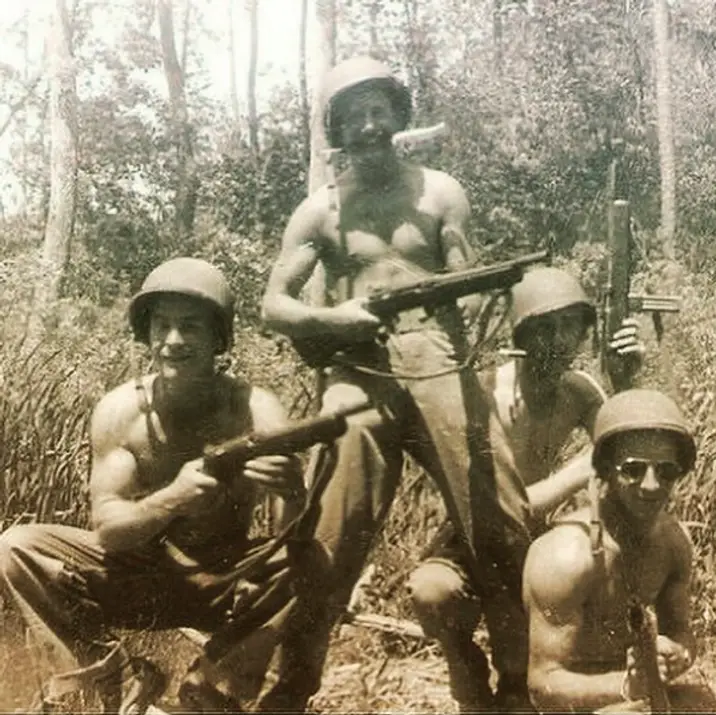
A group of USMC Marines pose with M50 submachine guns.
It seems that the result is more than good... But the military didn’t like something, and the army rejected Reising’s design. Here, however, a new customer unexpectedly appeared - the US Navy and the US Marine Corps as one of its structures.
Within the US Armed Forces, it was the Navy and Marine Corps that were pioneers in the use of submachine guns. By the time the Army adopted the Thompson submachine gun, Marines in Latin America and boarding crews of US Navy gunboats in China had already come to appreciate this rapid-fire weapon chambered for a pistol cartridge.
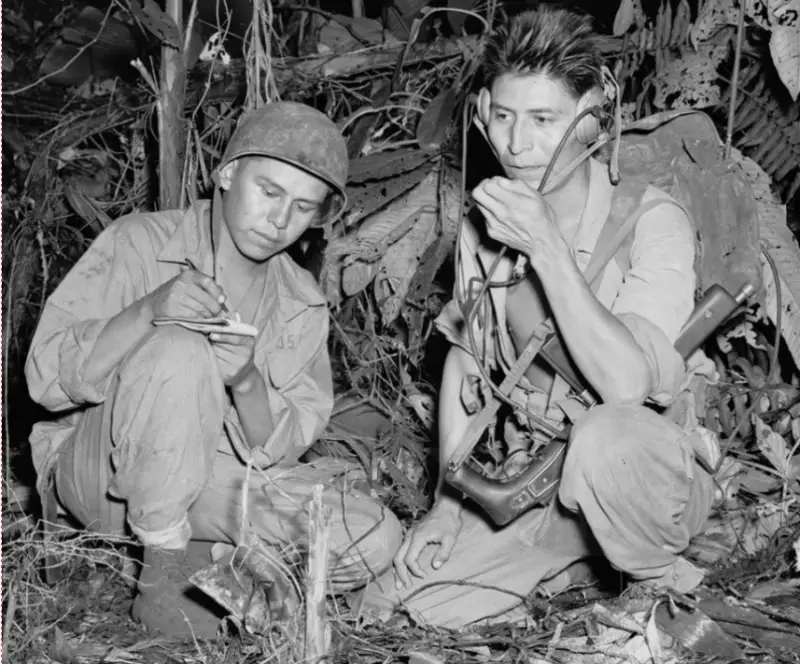
Those same “wind talkers” are USMC cryptographers from the Navajo tribe. Corporal Henry Bayeux and Private First Class George Kirk, Bougainville Island, December 1943. Kirk is armed with a Raising M55 submachine gun.
It was clear that in the emerging conflict in the Pacific theater of operations, the Marine Corps would play a huge role, and accordingly the USMC would grow... And a lot of submachine guns would be needed. But so far the output has clearly lagged behind the needs. It was necessary to saturate the army, the marines, and something had to be sent to the allies.
In addition, the Reising system had a number of advantages over the Thompson M1928A1 submachine gun. The “Raising M50” was lighter (almost 2 kilograms), much cheaper (more than 2 times), significantly more accurate when firing in short bursts, thanks to firing from a closed bolt and a retarder. In addition, at that time the USMC was creating its own parachute units, and for them the “Raising M55” looked very attractive, probably the most compact submachine gun chambered for the .45 ACP cartridge at that time.
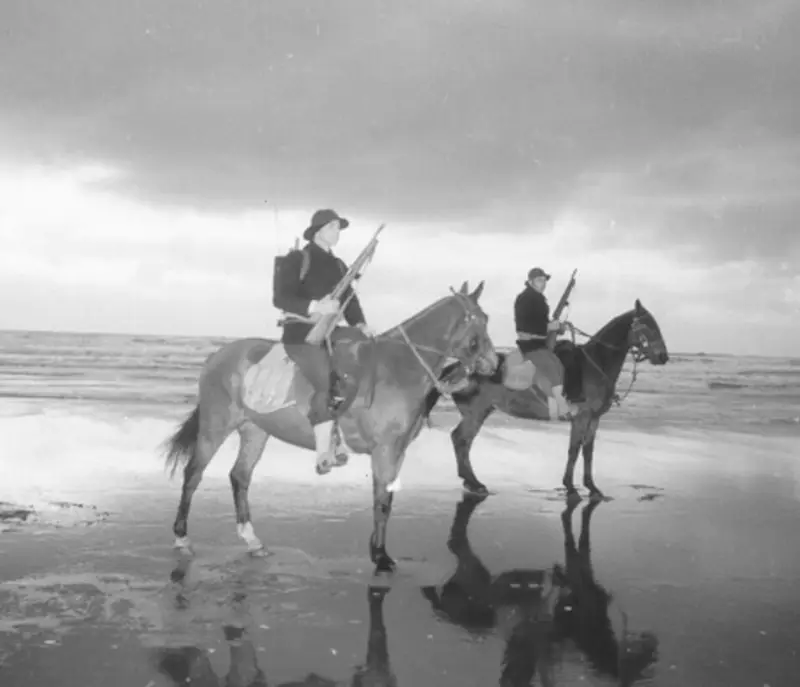
The legendary "naval cavalry". US Coast Guard Mounted Patrol, Florida, 1942. Both cavalry sailors are armed with the Rising M50.
And now the time has come for a baptism of fire in the Solomon Islands. And everything immediately turned out to be very bad. The system was quite complex and sensitive to contamination. Partial disassembly for cleaning was difficult and inconvenient. At dusk, and even more so in the dark, it was difficult to find the fuse. The metal coating did not match the conditions in which the weapon was exposed, and corrosion became a problem. The magazines turned out to be not strong enough, and the original magazine was only designed to hold 12 rounds. And so on and so forth.
Among other things, the soldiers on the front line discovered, one might say with horror, that many weapon parts were not interchangeable. The technological process at the plant was designed in such a way that the final assembly was carried out with manual fitting of parts. That is, it was simply impossible to assemble one worker from several faulty machines “on the front end.” It was necessary to send the weapon at least to the battalion weapons workshop, where there was a tool, in order, again, to manually adjust the parts.
And with the “landing” model, everything turned out to be bad; in addition to the pedigree problems, there was also a specific one, the wire butt was very inconvenient. It was impossible to invest in the weapon; the butt was digging into the shoulder.
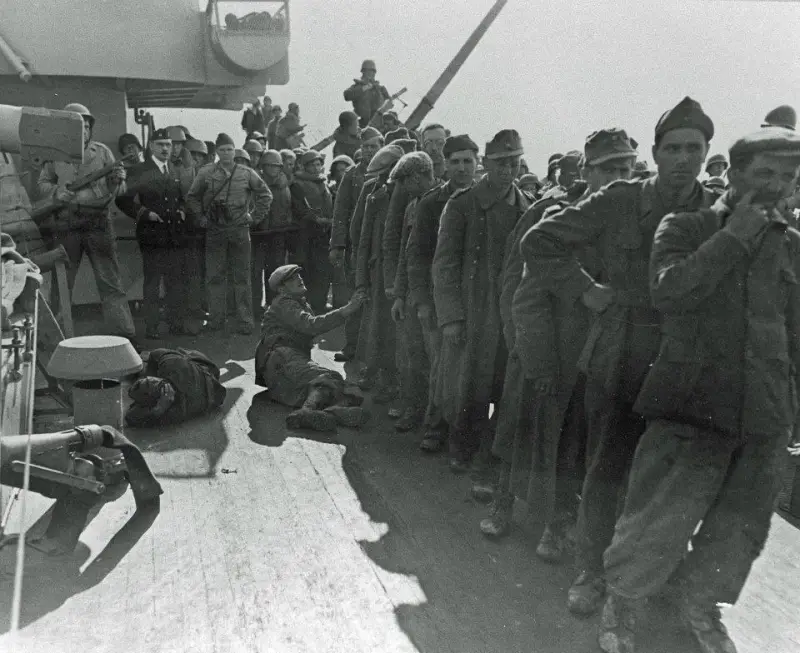
Some of the first prisoners captured by American forces at the Omaha landing sector, on the deck of the US Navy battleship Texas, June 6, 1944, Normandy, France. Several Marines from the ship's Marine unit can be seen in the background, one of whom is armed with an M50 submachine gun. Most of the prisoners are not even Germans, but Italians. After the capitulation of Italy, they were disarmed and sent to prisoner of war camps, and from there they were transported as HiVs to various German military units.
Some of the problems were due to the fact that openly civilian weapons ended up at the front, and even in the most difficult conditions of the jungle of the Pacific Islands. Formally, there is no difference between “civilian” and “military” raisings, but in fact, the first models that fell into the hands of the Marines and later ones are very different.
Some of the problems with weapons could well be called “childhood diseases”, because in January 1942 a contract for the supply of weapons was signed, and already in the summer the first submachine guns were baptized by fire. There were no full military tests before sending the weapon to the front. Everything was needed here and now. And some of the problems were subsequently resolved.
But the weapon’s reputation had already been tarnished by the humid tropical climate, the complexity of the system itself had not gone away, and the Thompson system was radically simplified twice in 1942, in addition, bringing the cost of one sample to a level comparable to the Reising system (in 1944 it even became lower ), plus they increased production volumes.
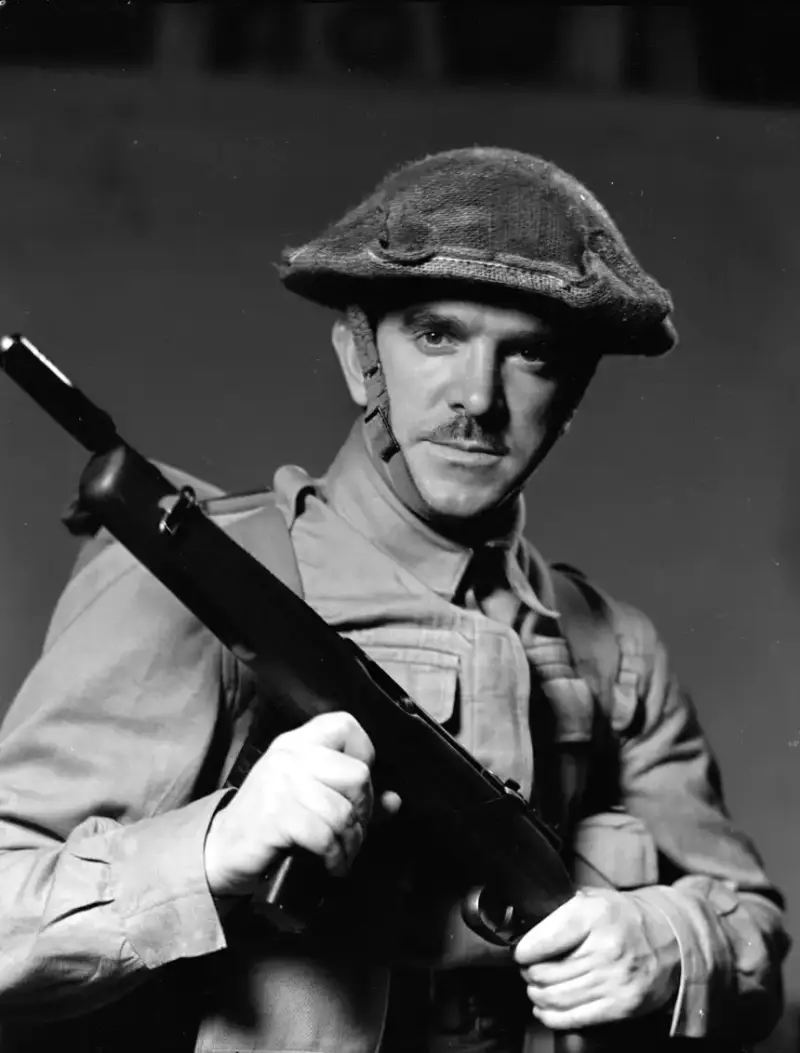
A Veterans Guard of Canada soldier with a Rising M50, Canada, 1943. The structure was created as an analogue of the British “army of dads”, but here everything was initially better. For example, only those who served during the First World War, but were no longer subject to conscription into the army for a new war, served. Accordingly, people here were trusted with more serious things than in Great Britain, such as the protection of strategic facilities, escorting and guarding prisoners of war. At least once it was even necessary to suppress a revolt of German prisoners of war, although it did not come down to weapons; they limited themselves to water cannons, gas, batons and heavy veteran fists.
In general, on this story submachine guns of the Eugene Reising system could have ended, but no.
Nevertheless, the system had a number of advantages, some of the “childhood illnesses” were cured, and the conflict that flared up at that time was of such a scale that no one had any extra weapons. There were tasks for the submachine gun in the rear and even at the front.
The same USMC continued to use the Rising M50 until the very end of the war. On all large ships of the US Navy there was a division of Marines that served as internal police (after all, it could often be a real small city, the population of which almost entirely consisted of young people, multiply all this by a permanently stressful state and physical activity, there are places where tension points arise ), boarding team, and according to the combat schedule usually occupied the positions of anti-aircraft gun crews. In the weapons shops of these units, raising was registered until the very end of the war.
Several thousand samples were purchased by the US Coast Guard for rear units and units patrolling the coast on foot, in equipment... and on horseback. Yes, yes, a joke about the naval cavalry, but that, as usual, is a completely different story.
These weapons also went into service with various police forces involved in the protection of strategic enterprises and facilities; there was also a clear lack of modern weapons; at the beginning of 1942, the most common weapon in such service were hunting shotguns.
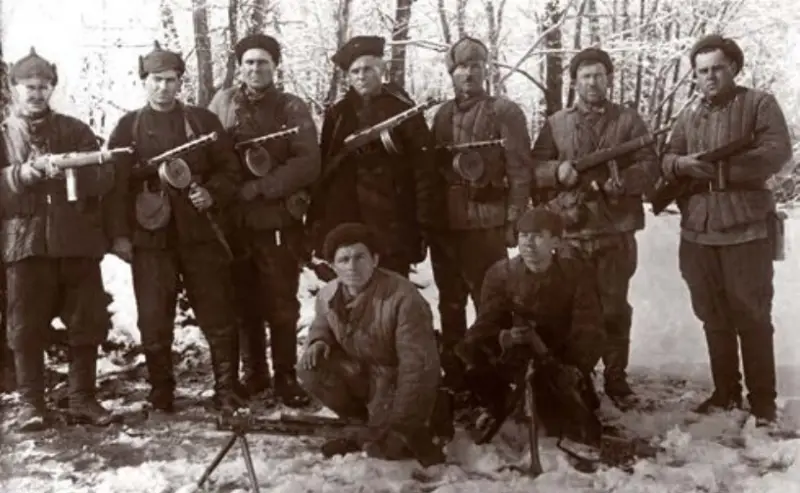
Scouts of the partisan detachment "Storm" (platoon of the Abinsk fighter battalion), Abinsk district of the Krasnodar Territory, winter 1942–1943. Three partisans are armed with Raising M50 submachine guns. There are a relatively large number of photographs of this partisan detachment. Judging by the photo, they went “to combat” with Soviet or German ammunition, leaving the “Americans” in the rear. Apparently, again, the shortage of non-standard cartridges had an effect.
The Americans also sent these weapons to their allies. This is how it ended up in the USSR. By the time they received these submachine guns, the Soviet military, who had previously encountered Thompsons (the first were supplied from the UK and are often designated as “British” in documents), clearly identified the main drawback of all systems chambered for the .45 ACP cartridge - this is the cartridge itself .
And the point is not in any of its terrible properties or the monstrous difference in penetrating ability and the stories going around about it (“put on two wet padded jackets and they will stop a bullet”), but in the fact that the cartridge was non-standard and was not produced in the USSR.
At the beginning of 1942, the ski battalions of the Bryansk Front were armed with many “British” Thompsons. And the documents of the Bryansk Front related to the actions of the ski battalions are literally riddled with one problem - solve the issue of ammunition, there is always not enough ammunition.
So the fate of the raisings in the USSR was predetermined from the very beginning - parts of the second echelon, guarding the rear, etc. But it was from the rear that these weapons came to the front.
How did it happen?
In July 1941, the formation of fighter squads began. They were formed by the NKVD from local party activists, police officers, business workers, etc. who were not subject to conscription. The range of tasks they solved, depending on the time and place of formation, was enormous. Somewhere they served to replenish the ranks of the Red Army units, somewhere they formed new full-fledged rifle units, somewhere they helped fight banditry and catch deserters, and somewhere, when German troops approached, they switched to partisan actions.
“Fighters” were often armed with whatever they needed, especially since they did not have to constantly fight, so non-standard weapons with non-standard ammunition were a frequent occurrence. Thus, during Operation Blau, along with the NKVD fighter battalions, the American submachine guns already issued to them went to the partisans.
In the USSR in 1942, they tested the Eugene Reising system upon receipt of weapons. Our gunsmiths were frankly not interested in the system and were noted by the complexity of the design, as well as the high requirements for processed parts, which our gunsmiths considered unacceptable in the conditions of mass military production.
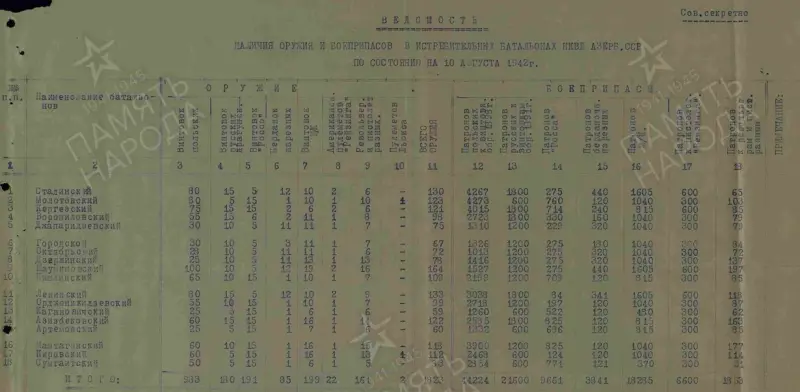
List of the availability of weapons and ammunition in the destroyer battalions of the NKVD of the Azerbaijan SSR as of August 10, 1942. There are not many Risings (column No. 8), but they are often the only automatic weapons of these units.
In general, the history of submachine guns of the Reising system cannot be called brilliant, but they were not a complete failure either.
Production continued throughout the war (though only M60 carbines; production under a contract with the USMC ceased in 1943), and about 80 thousand samples were produced only under a contract with the USMC. Subsequently, the samples decommissioned from the US armed forces were sold on the civilian market and served for a long time in various US law enforcement agencies.
In general, despite the efforts and ideas of Eugene Reising, he ended up with a classic “civilian” submachine gun of the 1930s. Wartime presented not just different, but radically different requirements for weapons.
The Reisings did not have the gangster flair of the Thompsons, the cheapness of the walls, or the mass production of PPSh, but they left their mark on weapons history and honestly served on the fronts of World War II, and in completely different conditions and literally on different ends of the globe.
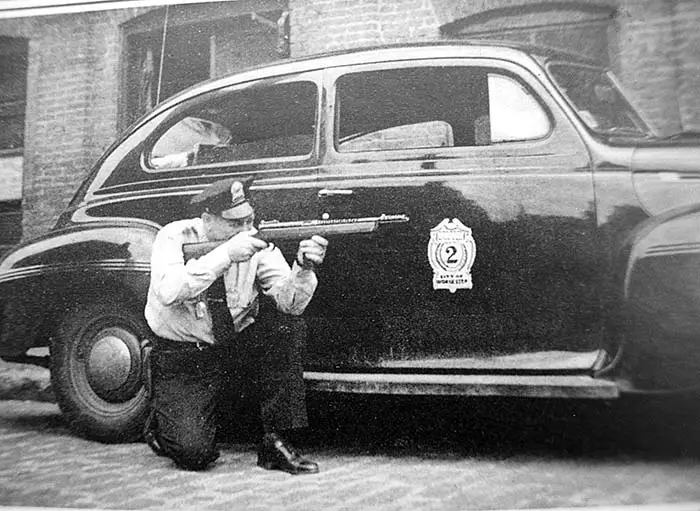
After the war, the raisings returned to where they probably belonged - in various law enforcement structures and agencies of the United States. Still, it turned out to be a good example of a weapon, but not for war and mass production conditions.
Information